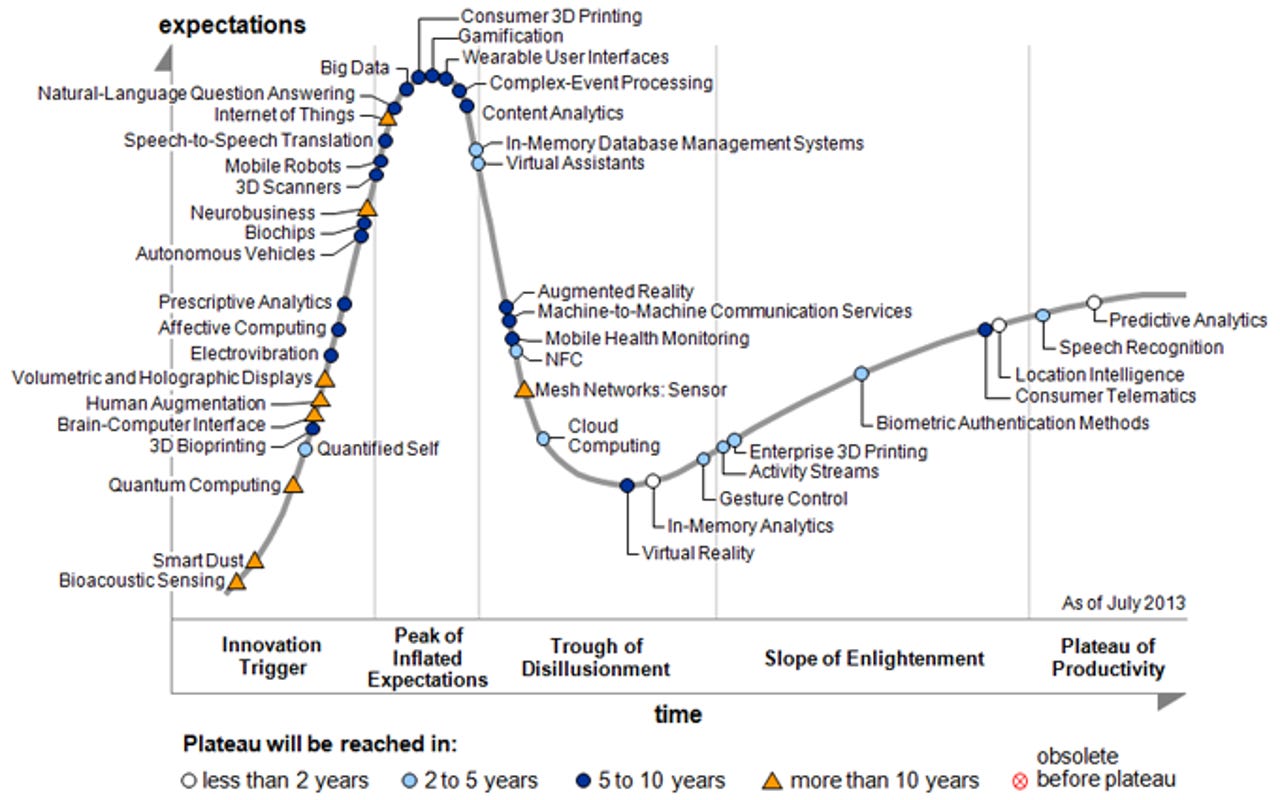Gartner's 2013 Emerging Technologies hype cycle focuses on humans and machines

The 2013 edition of Gartner's long-running Hype Cycle for Emerging Technologies focuses on "the evolving relationship between humans and machines … due to the increased hype around smart machines, cognitive computing and the Internet of Things."
Gartner fellow Jackie Fenn, who came up with the hype cycle idea in 1995, says "there are actually three main trends at work. These are augmenting humans with technology — for example, an employee with a wearable computing device; machines replacing humans — for example, a cognitive virtual assistant acting as an automated customer representative; and humans and machines working alongside each other — for example, a mobile robot working with a warehouse employee to move many boxes."
Fenn's collaborator Hung LeHong says these trends have been made possible because machines are becoming better at understanding humans and humans are becoming better at understanding machines. "At the same time, machines and humans are getting smarter by working together."
The three main trends are:
1. Augmenting humans with technology
Companies can improve workers' performance or the level of customer service using augmentation devices such as wearable computers. Gartner says: "Organizations interested in these technologies should look to bioacoustic sensing, quantified self, 3D bioprinting, brain-computer interface, human augmentation, speech-to-speech translation, neurobusiness, wearable user interfaces, augmented reality and gesture control."
2. Machines replacing humans
Robots have been used on the factory floor for decades but improvements in technology mean there is still plenty of scope for automating both physical and mental procedures. Gartner says: "Organizations should look to some of these representative technologies for sources of innovation on how machines can take over human tasks: volumetric and holographic displays, autonomous vehicles, mobile robots and virtual assistants."
3. Humans and machines working alongside each other
Gartner says: "The main benefits of having machines working alongside humans are the ability to access the best of both worlds (that is, productivity and speed from machines, emotional intelligence and the ability to handle the unknown from humans). Technologies that represent and support this trend include autonomous vehicles, mobile robots, natural language question and answering, and virtual assistants." One example is IBM's Watson working alongside doctors and providing natural-language question answering (NLQA).
At this futuristic level, Gartner says "enterprises should consider quantum computing, prescriptive analytics, neurobusiness, NLQA, big data, complex event processing, in-memory database management system (DBMS), cloud computing, in-memory analytics and predictive analytics."

The point of the Hype Cycle is to give enterprises some idea how far various technologies are from the "plateau of productivity" where they can be more easily adopted. The cycle has five stages, for which Gartner uses terminology reminiscent of John Bunyan's Pilgrim's Progress. It starts with a Technology Trigger: a new invention or innovation. That gets the attention of the media, analysts, conference organizers etc, which drives the idea to a Peak of Inflated Expectations. At this point, disillusion sets in. As I noted in the Guardian in 2005, "The press, having overhyped it, knocks it for being overhyped, and it descends into the Trough of Disillusionment." Successful innovations pass through the trough and start to climb the Slope of Enlightenment before reaching the Plateau of Productivity.
In the 2013 hype cycle, Technology Triggers include SmartDust, brain-computer interfaces, and quantum computing, all of which Gartner reckons are 10 years or more from the plateau. It reckons autonomous vehicles and biochips are 5-10 years away.
Technologies at the overhyped stage include "big data", consumer 3D printing, gamification, and wearable user interfaces.
Overhyped technologies now plunging into the Trough of Disillusionment include mobile health monitoring, NFC and cloud computing.
Technologies that are climbing the slope or already becoming productive include gesture controls, biometric authentication systems, speech recognition and predictive analytics.
Gartner's Hype Cycle for Emerging Technologies, 2013 ($1,995) "includes a video in which Ms Fenn provides more details". Fenn and LeHong are also hosting two free webinars at 3pm and 6pm (UK time) on August 21, registration required.